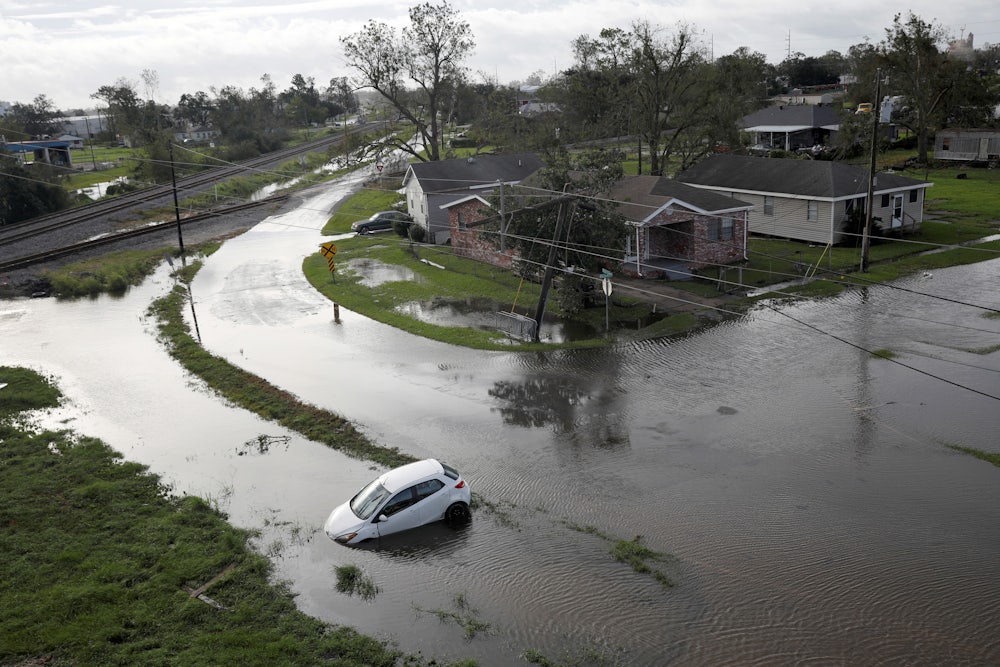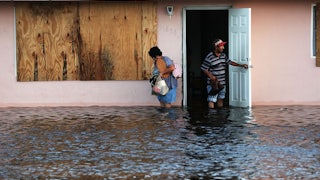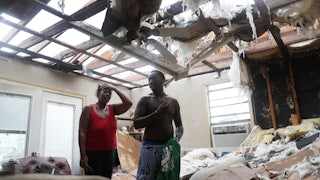“The wind is tearing Pointe-Aux-Chenes apart,” Albert Naquin told me Sunday afternoon. He was standing in his carport, watching as the first eyewall of Hurricane Ida passed over the bayou where he has lived for almost his entire life. Naquin is the chief of the Ile de Jean Charles band of Biloxi-Chitimacha-Choctaw, a Native American tribe with centuries of history in the marshland of Louisiana. The storm was not over yet, not even halfway over, and already Naquin was mourning the nearby island that his tribe has called home for generations: “I don’t think we will have any houses left on the island,” he said.
Other holdouts in Pointe-Aux-Chenes were telling me the same thing, sending photos and videos to prove it. As the wind continued to beat down on the bayou, it ripped off roof shingles one by one, threatening to leave homes exposed to the pounding rain. The wind knocked down oak trees, flipped trailers upside down, and dragged sparking power lines to the ground. When the gale reversed direction, broken-off shards of shingle and plaster flew around in every direction as though caught in a tornado. Mobile homes collapsed, then regular homes collapsed. The fire station roof peeled off and disappeared.
This was the scene in a single town, on a single bayou, in a single parish. Over the next 12 hours, comparable scenes would play out across the state of Louisiana and beyond as the hurricane continued to churn north, creeping first over New Orleans and then over Baton Rouge. If it wasn’t the wind, it was the storm surge; if it wasn’t the storm surge, it was the rain and the flash flooding that followed it.
When the skies have cleared and the damage has been assessed, Hurricane Ida will stand almost peerless among hurricanes in the breadth and depth of its devastation. In every meaningful sense, it was the perfect storm of the climate change era—not just in terms of meteorology but also in terms of geography, history, and victimology. This storm brings the climate crisis full circle, unleashing the wrath of a world warmed by fossil fuels on the very state that is the site of some of the fossil fuel industry’s greatest crimes.
Granted, you might not know this from watching cable news. General Russell Honoré, the retired commander who steered the military’s response to Hurricane Katrina in 2005, told the Weather Channel just before Ida made landfall that “anything built by man can be destroyed by Mother Nature”—as if Mother Nature alone were to blame for this particular storm.
It’s true that the Gulf Coast has long attracted epochal hurricanes: The Last Island hurricane ravaged the state’s coast in 1856, and the devastating Hurricane Camille traced almost the same path as Ida in 1969. Both of these storms struck before significant global heating had gotten underway. But while Ida may recall those ancient storms, things are different now. Louisiana is a different place, and Mother Nature behaves in a different way. It is impossible to talk about Ida without talking about the climate crisis.
The first way Ida reflects climate change is in its stunning growth trajectory, which horrified many weather experts well before it made landfall. Ida exhibited what is known as “rapid intensification.” When a tropical cyclone passes over warm water, the surface energy of the water lifts up into the vortex and acts as fuel for the storm. The warmer and deeper the water, the faster the storm grows and the more powerful its peak winds become.
As Hurricane Ida approached the Gulf Coast, it passed over a deep eddy of water that registered a temperature of almost 90 degrees. The Gulf of Mexico is very complex, and it’s hard to say with certainty why any part of it is hot at any given time, but more than 90 percent of anthropogenic warming has been absorbed by the oceans, and the process of planetary heating makes high sea-surface temperatures like the ones we are observing now much more likely. The past few years have seen an unprecedented spate of storms that display the so-called rapid intensification phenomenon: First Irma obliterated the Keys in 2017, then Michael slammed into the Florida Panhandle in 2018, and then last year Hurricane Laura devastated the western Louisiana city of Lake Charles.
The rapid intensification made it impossible for New Orleans to prepare for the storm. In order for the city to issue a mandatory evacuation, the state government needs to be able to implement what is known as contraflow, wherein inbound lanes of major highways are reversed so that evacuees can use every lane. This is a massive logistical undertaking that requires at least three days of advance notice, not least because tens of thousands of people in the bayou parishes must travel through New Orleans in order to leave the region.
The government of New Orleans did not have three days: Three days ago, Ida was a poorly organized rain system in the Caribbean, hardly even a tropical depression. Rapid-intensification storms upend the normal calculus of hurricane preparation. Climate change will make these storms more common.
Louisiana’s vulnerability to the storm can also be traced to fossil fuels. The Gulf Coast of the state used to be lush with land, thousands of barrier islands and peninsulas that slowed down approaching storms and shielded coastal residents from the worst surge flooding. When oil companies like Texaco arrived in the early twentieth century, they and their enablers in the state government carved the bayou up, dredging dozens of canals to allow for the transportation of oil and laying down several gas pipelines as well. These new canals allowed salt water to push up through rivers and streams, and within decades the marshland had begun to erode. When the warming of the ocean accelerated in the later part of the century, the waters expanded and rose, furthering the process of erosion.
The result, as one can see from even the most cursory glance at a satellite map, is that the “boot” of Louisiana frayed and fell apart. Solid land that had once supported gardens and cattle pastures became muddy and impossible to traverse, and year by year the flooding from hurricanes and rainstorms got worse. The buffering marshland of the coastline degraded into a kind of besieged fortress, with almost the entire permanent population protected by a mishmash of levees and floodwalls, some maintained by local governments and others by the infamous U.S. Army Corps of Engineers, whose design failures caused the humanitarian disaster that was Katrina.
The few remaining places outside this intricate levee system, including Ile de Jean Charles and the Indigenous village of Grand Bayou farther to the east, were wiped clean by the storm, just as Naquin predicted they would be. Details were hard to come by as of Monday morning, but the storm surge in both locations reached at least seven feet, enough to inundate or destroy almost any houses not already sheared apart by wind. The state of Louisiana has been working for years to carry out a controversial resettlement program that would move the residents of eroding Ile de Jean Charles to a new inland site, and the storm dealt this plan a blow, as well: After it passed over Naquin’s house, it slammed the resettlement area, too.
Areas inside the levee system did not fare much better. The storm refused to weaken at first, as it passed over land, and before long the wind was knocking down buildings in cities like New Orleans and Houma that are far from the gulf; electricity went out and stayed out at a hospital in Thibodaux, forcing nurses to ventilate Covid-19 patients by hand. In the town of Lafitte, a shrimp fisherman named Ronald Dufrene watched from his shrimp boat as water overtopped the local levees and rushed chest-deep into the town. Elsewhere, along the Mississippi River, water sloughed over the levees in at least three places, filling up towns like LaPlace and trapping residents inside their homes.
In New Orleans, at least, the Army Corps levee structure held up, but other infrastructure failed. Several electrical transformers blew early in the day, and the Entergy transmission tower that provides power to almost the entire city collapsed into the Mississippi River later in the evening, which could leave the entire city without electricity for days, if not weeks. The loss of power also deprived the city’s water pumps of the energy they needed to push rainwater out of the city, which forced the local board to rely on what it called “self-generated power” and a single turbine. As the night wore on, the water kept rising. It was still unclear by morning how long it would take to restore power.
While the full toll of the storm remains to be seen, it’s not too early to perceive the broader lesson here: We now live in a world for which our current ways of building and living are inadequate. We have underestimated the risk posed by disasters like hurricanes and wildfires, and we must now rethink our relationship to the natural forces that terrorize marginalized communities like Naquin’s. The culprits in this crime, and the entities that by all rights should pay for its restitution, are the fossil fuel companies, and the oil majors in particular.
The brutal irony of the whole affair is that these companies still enjoy incredible status in Louisiana. Ida made its earliest landfall at Port Fourchon, a marine complex that services about 20 percent of the nation’s oil supply; given the potential for hurricane damage to affect gas prices, it is a safe bet that officials will devote extensive early resources to restoring the port’s operations. Although most oil production in the region has moved offshore, Louisiana is still a stronghold for the petrochemical industry, and the swath of land the hurricane traversed is home to an estimated 600 refineries and chemical plants; there are dozens of these plants along the spine of the Mississippi River in Plaquemines Parish and hundreds more in “Cancer Alley,” the cluster of polluted refinery towns between New Orleans and Lafayette. Even in a place like Pointe-Aux-Chenes, many people work for the fossil fuel industry in some capacity, for instance on the tugboats that bring oil barges up the Mississippi.
That the same people who lived and worked under the yoke of the fossil fuel industry for more than a century should now reap the consequences of that industry’s negligence is a manifest injustice. In the coming weeks, we will hear a great deal about building back better, about the need to restore our infrastructure and harden it for future climate disasters. And we do need to do that. But the pointed, historically specific nature of Ida’s devastation should make us rethink what we mean by recovery. We need to interrupt a vicious cycle of climate cause and effect, a feedback loop that is more extreme in Louisiana than almost anywhere else. If we restore every house and every levee, and we leave untouched the industries that polluted the world in the first place, to what extent can we really say we have “built back better”?








